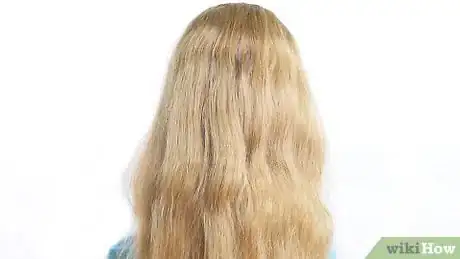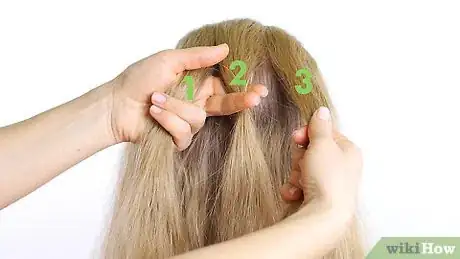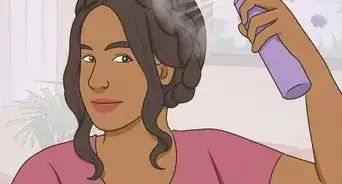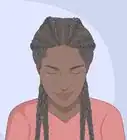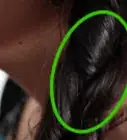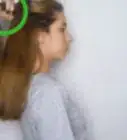This article was co-authored by Ndeye Anta Niang. Ndeye Anta Niang is a Hair Stylist, Master Braider, and Founder of AntaBraids, a traveling braiding service based in New York City. Ndeye has over 20 years of experience in African hair including braiding box braids, Senegalese twists, crochet braids, faux dread locs, goddess locs, kinky twists, and lakhass braids. Ndeye was the first female of her tribe in Africa to move to America and is now sharing her knowledge of African braids passed on from generation to generation.
There are 7 references cited in this article, which can be found at the bottom of the page.
wikiHow marks an article as reader-approved once it receives enough positive feedback. This article received 25 testimonials and 85% of readers who voted found it helpful, earning it our reader-approved status.
This article has been viewed 3,709,542 times.
The Dutch braid goes by many names, including the "reverse French braid." In fact, the Dutch braid is done exactly like a French braid, except that you cross the strands under instead of over. It may look complex to a beginner, but it is actually quite simple! A basic Dutch braid will work on most lengths of hair, but if you have very short hair, consider a double Dutch braid instead.
Steps
Making a Basic Dutch Braid
-
1Start with neatly brushed, dry or damp hair. You can do a Dutch braid on dry or damp hair, but it needs to be brushed and free of any knots or tangles. If you have any flyaways, lightly mist them with water or tame them with a smoothing product like a serum or pomade.
- Braiding on wet hair is a great way make your hair curly without using heat. You will have to let your hair dry completely before taking the braid out, however.
-
2Brush your hair straight back, then gather a section from the hairline. Comb your hair straight back so that you don’t have any side or center parts. Slide your thumbs through your hair to gather a section from your front hairline. This section should span the width of your forehead.
- With this method, you’ll create one large braid down the center of your head.
- Alternatively, you can gather your hair into a half-up, half-down pony tail that is at about eyebrow or eye level.
Advertisement -
3Split the section into 3 equal strands. Hold the right strand in your right hand, and the other 2 in your left hand. Let the middle strand drape over your middle finger, and hold the left strand against your palm with your pinkie. This will keep them separate.
- You will be starting your braid from the right side. If starting from the left is more comfortable for you, simply reverse everything.
-
4Begin a standard braid to anchor the Dutch braid. Cross the right strand under the middle strand, then cross the left strand under the new middle strand. It is very important that you cross these 2 strands under instead of over, like in a standard braid. If you don’t do this, the Dutch braid won’t turn out right.[1]
-
5Add a thin section of hair to the right strand before crossing it under the middle one. Gather a thin strand of hair from the right side of your hairline and add it to the right strand. Treating the 2 strands as one, cross them under the middle strand. Use your fingers to smooth down any stray hairs and ensure that the braid is tight.[2]
- The thin strand should be a little smaller than the right strand you are adding it to.
- Some people find it easier to cross the right strand first, then add the hair to it. Make sure that the added hair is going under the middle strand.
-
6Repeat the process on the left side. Gather a thin strand of hair from the left side of your hairline. Add it to the left strand, then cross it under the middle strand. Smooth down any stray hairs and make sure that the braid is tight.[3]
- Again, you can cross the strand first, then add hair to it. Make sure that it’s going under the middle strand.
-
7Continue to Dutch braid until you reach the nape of your neck. Add thin strands of hair to the right and left strands before crossing them under the middle one. Keep the thin strands consistent in size, and make sure that you braid as tightly as is comfortable for you. You can always loosen the braid up later. When you reach the nape of your neck, stop.[4]EXPERT TIP
A Dutch braid is also known as "renversee," which means "reverse," because it's the opposite of a French braid.
Ndeye Anta Niang is a Hair Stylist, Master Braider, and Founder of AntaBraids, a traveling braiding service based in New York City. Ndeye has over 20 years of experience in African hair including braiding box braids, Senegalese twists, crochet braids, faux dread locs, goddess locs, kinky twists, and lakhass braids. Ndeye was the first female of her tribe in Africa to move to America and is now sharing her knowledge of African braids passed on from generation to generation.
Ndeye Anta Niang
Professional Hair Stylist & Master Braider Ndeye Anta Niang
Ndeye Anta Niang
Professional Hair Stylist & Master Braider -
8Finish off with a standard braid. Gather the remaining hair into the right, middle, and left strands, making sure to distribute it evenly. Finish off with a regular braid by crossing the right and left strands under the middle one. Keep your stitches tight and smooth. You can tie the braid off when you have about 2 inches (5.1 cm) left, or continue braiding down to the very end.[5]
- When the braid becomes too long to braid down your back, bring it over one of your shoulders.
-
9Loosen the outer strands of the braid to make it fuller, if desired. Starting from the end of your braid, gently tug on the outer strands to loosen them up. For a more carefree look, muss up the fine hairs at your hairline as well. Don't get carried away, however; your braid will loosen on its own throughout the day.[6]
Making a Double Dutch Braid
-
1Start with neatly-brushed hair. Your hair can be wet or dry, but it needs to be brushed and free of tangles or knots. Braiding your hair wet will make your hair curly if you let the braid dry, then take it out.
-
2Part your hair down the center for a symmetrical look. Use the handle of a rat-tail comb to part your hair down the center, from forehead to nape. Brush the left side of your hair over your left shoulder, and the right side over your right shoulder.
-
3Make a side part for a cool, off-center style. Starting at your hairline, part your hair to the left or right side. As you trace the part back towards the crown, gradually bring it to the center. The part should be right down the center from the crown of your head down to the nape.
-
4Gather a thin section of hair from the left side. Clip or tie the right side of your hair out of the way. Next, gather a 2-inch (5-cm) wide section of hair from the left side of your hair, right at the hairline.[8]
- You can start from the right side, if you prefer, but you'll need to do everything in reverse order.
-
5Split the section into 3 equal strands. Hold the left strand in your left hand, and the other 2 strands in your right. Keep the middle strand draped over your middle finger, and hold the right strand against your palm with your pinkie.
-
6Begin a standard braid. Cross the left strand under the middle strand, then cross the right strand under the new middle strand. Gently tug on the strands to tighten them. Make sure that you are crossing under the middle strand and not over, otherwise the Dutch braid won't work.[9]
- If you are starting on the right side of your head, cross the right strand under the middle one first instead.
-
7Add some hair to the left strand, then cross it under. Gather a thin section of hair from the left side of your hairline, and add it to the left strand. Treating the two strands as one, cross them under the middle strand. Use your fingers to smooth down any stray strands of hair, if needed.[10]
- The thin section should be a little smaller than the one you are adding it to.
- You can cross the left strand under the middle one, then add the thin section of hair to it. Some people find it easier that way.
-
8Repeat the process for the right strand. Gather a thin section of hair, this time from the part. Add it to the right section to make it thicker, then cross it under the middle strand.[11]
-
9Continue to Dutch braid until you reach your nape. Keep adding thin strands of hair to the left and right strands before crossing them under the middle one. Keep the strands even in size and tension. Try to center the braid between your part and hairline.
-
10Finish off with a regular braid. Gather whatever hair you have left over on the left side, and distribute it evenly between the left, right, and middle strands. Continue crossing the left and right strands under the middle one until you get to the end of your hair. Tie the braid off with a small hair tie.[12]
- If you have very short hair, you may not have enough hair left to braid. Simply tie it off as a mini pigtail.
-
11Repeat the process on the other side of your head. Gather a thin section of hair from your hairline and split it into 3 smaller ones. Begin braiding with the right strand this time. Start with a regular braid for 2 cross unders, then continue with a Dutch braid until you reach your nape. Finish off with a regular braid, then tie it off.
-
12Wrap or twist the braids into a bun or crown, if desired. You don't have to do this at all, but it's a great way to update your style and get your hair off of your back. Alternatively, you can tie the 2 braids into a ponytail instead. Here are some ideas to get you started:
- Mini buns: twist each braid into a bun, tucking the tails underneath and out of sight. Secure the buns with bobby pins.[13]
- Braided crown: wrap the left regular braid around the back of your head and pin it to inside edge of the right Dutch braid. Repeat for the right braid and left Dutch braid.[14]
- Relaxed ponytail: gather the 2 braids together and secure them with a hair tie. Remove the 2 smaller hair ties, and undo the braids. Wrap a thin strand of hair around the ponytail to hide the elastic, then secure it with a bobby pin.[15]
Expert Q&A
-
QuestionHow do you do a Dutch braid step by step?
 Laura MartinLaura Martin is a Licensed Cosmetologist in Georgia. She has been a hair stylist since 2007 and a cosmetology teacher since 2013.
Laura MartinLaura Martin is a Licensed Cosmetologist in Georgia. She has been a hair stylist since 2007 and a cosmetology teacher since 2013.
Licensed Cosmetologist Start with a small section divided into thirds. Cross right under center, then left under new center. On the right, pick up some more hair and add to the section, then cross under center; repeat picking up hair and crossing under on the left. Alternate crossing right and left under center adding more hair until all hair is incorporated; plait to ends.
Start with a small section divided into thirds. Cross right under center, then left under new center. On the right, pick up some more hair and add to the section, then cross under center; repeat picking up hair and crossing under on the left. Alternate crossing right and left under center adding more hair until all hair is incorporated; plait to ends. -
QuestionCan you make the braid go sideways?
 Ashley AdamsAshley Adams is a Licensed Cosmetologist and Hair Stylist in Illinois. She completed her Cosmetology education at John Amico School of Hair Design in 2016.
Ashley AdamsAshley Adams is a Licensed Cosmetologist and Hair Stylist in Illinois. She completed her Cosmetology education at John Amico School of Hair Design in 2016.
Professional Hair Stylist Yes, definitely. You can braid one large, slanted dutch braid braided on the side of your head. You could even get creative with parting your hair and still achieve side braids.
Yes, definitely. You can braid one large, slanted dutch braid braided on the side of your head. You could even get creative with parting your hair and still achieve side braids. -
QuestionCan you do a Dutch braid with a fringe?
 Ashley AdamsAshley Adams is a Licensed Cosmetologist and Hair Stylist in Illinois. She completed her Cosmetology education at John Amico School of Hair Design in 2016.
Ashley AdamsAshley Adams is a Licensed Cosmetologist and Hair Stylist in Illinois. She completed her Cosmetology education at John Amico School of Hair Design in 2016.
Professional Hair Stylist Yes! You can either leave your fringe out of the braid, or conceal it by pulling it into the braid. To keep it out of the braid, clip it out of the way and braid normally. If you want to add your fringe into the braid, smooth it back with the rest of your hair. To keep the ends from sticking out, apply a bit of smoothing serum or pomade.
Yes! You can either leave your fringe out of the braid, or conceal it by pulling it into the braid. To keep it out of the braid, clip it out of the way and braid normally. If you want to add your fringe into the braid, smooth it back with the rest of your hair. To keep the ends from sticking out, apply a bit of smoothing serum or pomade.
Things You'll Need
Making a Basic Dutch Braid
- Hair brush
- Hair tie
- Bobby pins (optional)
Making a Double Dutch Braid
- Hair brush
- Rat-tail comb
- Hair ties
- Bobby pins (optional)
References
- ↑ https://www.luxyhair.com/blogs/hair-blog/how-to-do-a-dutch-braid-hair-tutorial-for-beginners
- ↑ https://www.luxyhair.com/blogs/hair-blog/how-to-do-a-dutch-braid-hair-tutorial-for-beginners
- ↑ https://www.luxyhair.com/blogs/hair-blog/how-to-do-a-dutch-braid-hair-tutorial-for-beginners
- ↑ https://www.luxyhair.com/blogs/hair-blog/how-to-do-a-dutch-braid-hair-tutorial-for-beginners
- ↑ https://www.luxyhair.com/blogs/hair-blog/how-to-do-a-dutch-braid-hair-tutorial-for-beginners
- ↑ https://www.luxyhair.com/blogs/hair-blog/how-to-do-a-dutch-braid-hair-tutorial-for-beginners
- ↑ http://abeautifulmess.com/2013/10/how-to-style-a-simple-dutch-braid.html
- ↑ https://www.allthingshair.com/en-uk/hairstyles-haircuts/braids/how-to-do-a-dutch-braid/
- ↑ https://www.allthingshair.com/en-uk/hairstyles-haircuts/braids/how-to-do-a-dutch-braid/
- ↑ https://www.allthingshair.com/en-uk/hairstyles-haircuts/braids/how-to-do-a-dutch-braid/
- ↑ https://www.allthingshair.com/en-uk/hairstyles-haircuts/braids/how-to-do-a-dutch-braid/
- ↑ https://www.allthingshair.com/en-uk/hairstyles-haircuts/braids/how-to-do-a-dutch-braid/
- ↑ https://www.allthingshair.com/en-uk/hairstyles-haircuts/braids/how-to-do-a-dutch-braid/
- ↑ http://www.hairromance.com/2017/07/best-wet-hair-braids-tutorial.html
- ↑ https://www.allure.com/story/easy-dutch-braid-ponytail
- ↑ http://stylecaster.com/beauty/dirty-hair/
- ↑ http://stylecaster.com/beauty/dry-shampoo-tricks/
- ↑ https://www.luxyhair.com/blogs/hair-blog/how-to-do-a-dutch-braid-hair-tutorial-for-beginners
About This Article
To Dutch braid your hair, first separate your hair into a top section and a bottom section. Hold the top section with both hands, and let the bottom section hang down. Then, divide the top section of your hair into 3 equal strands. Pass the right strand under the middle strand, then pass the left strand under the middle strand. Now, grab some more hair with your hand that’s holding the right strand, and pass the new section of hair under the middle strand along with the right strand. Grab some more hair with your hand that’s holding the left strand, and do the same thing. Continue braiding your hair like this until you’ve added all of the hair from the bottom section. Then, braid the rest of the 3 strands in your hand like a normal braid. Finally, secure the braid with a hair tie when you get to the end, and you're done. For more details and styling ideas, keep on reading!
